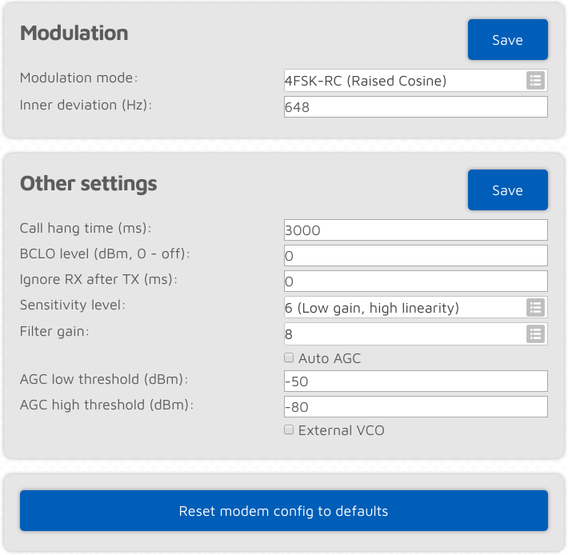Modem page
You can change the modem settings on this page.
If you change the modem mode, RX or TX frequency on this page, the values will be copied to the currently active connector's settings. If Advanced mode is turned off, both RX and TX frequencies will be automatically set to the same value (the separate RX and TX frequency fields will be hidden).
If the Idle modem mode is activated then the openSPOT3's modem won't transmit and will ignore all received transmissions.
In case you have half deviation enabled in your C4FM/Fusion® radio (some models don't have this setting and have half deviation mode enabled by default), use the C4FM Half Deviation modem mode.
Frequency

The Modem receive frequency offset setting can be used to correct the frequency difference (RX offset) between the openSPOT3 and the used transmitter. This setting is only available if Advanced mode is enabled.
Setting an RX offset may be needed in case others report that transmissions coming from your transceiver have voice quality issues. This should rarely happen as the openSPOT3 has a built-in, factory calibrated, extreme accurate clock reference. You can also use the AutoCal special connector to find out the required RX offset value, or you can use the openSPOT3's built-in local echo service to find out the RX offset value yourself by listening back your recorded voice.
CW ID

You can set a CW ID which the openSPOT3 will transmit at the specified interval with the specified speed. You can use letters, numbers, slash (/) and space characters in the ID.
The openSPOT3 transmits an unmodulated carrier wave by default, so you'll only be able to hear it using a radio which is capable of CW/SSB demodulation. You can turn on Audible CW ID, so the carrier wave will be modulated, and you'll be able to hear it on a regular FM receiver. Note that if Audible CW ID is turned on, the openSPOT3 transmits the CW ID without going to RX between dits and dahs, so you won't be able to transmit using your transceiver while the CW ID is transmitted.
Before the openSPOT3 starts to transmit the CW ID, it waits at least TX delay seconds after the last received call. An incoming call (both from a radio or from the network) will interrupt the CW ID transmission, so enabling the CW ID does not interfere with the openSPOT3's normal operation.
Other modem settings

If Advanced mode is enabled, you can tweak various other modem parameters at the bottom of the modem page.
The Call hang time setting specifies how many milliseconds the openSPOT3 will wait after the last valid frame has been received to consider a call has been finished with a timeout.
If the BCLO level (BCLO - Busy Channel Lock Out) setting is not 0, then the openSPOT3's modem will only start a transmission if its RSSI meter does not measure a signal strength above the specified BCLO value in dBm.
The Ignore RX after TX setting specifies a time for which all received frames by the modem will be ignored after the last TX has ended. This is useful if you want to use the openSPOT3 to link a repeater to the internet through RF and the repeater has a lengthy internal buffer and it is still transmitting even after the openSPOT3 has finished transmitting (which means the openSPOT3 will start receiving its own stream again).
The modem's Sensitivity level can be changed in 6 levels. Note that increasing sensitivity decreases the linearity of the filters, which may result in incorrectly demodulated bits (which means increased BER). By default, sensitivity is low (level set to 5 or 6) for modem modes using 4FSK.
The sensitivity of the modem's filter can be changed with the Filter gain setting. Note that increasing sensitivity decreases the linearity of the filters, which may result in incorrectly demodulated bits (which means increased BER). By default, filter gain is set to 8.
The modem's AGC (Auto Gain Control) is configured by software for optimal values for low BER in 4FSK demodulation modes. However, you can turn automatic AGC on with the Auto AGC setting, but it is recommended to keep this checkbox off so the openSPOT3's AGC can work on its own.
When the AGC is turned on, you can set the AGC low/high threshold values. These values will be considered as low and high thresholds for the Auto AGC circuitry in the modem.
The External VCO checkbox should be checked when an external VCO is applied to the openSPOT3. Currently there's no external VCO used by the openSPOT3. Note that applying an external VCO is considered as an after-market modification and voids the warranty of the openSPOT3.
You can also reset all modem settings back to defaults by clicking on the Reset modem config back to defaults button.
All of the settings above are stored independently for each modem mode in the current profile.